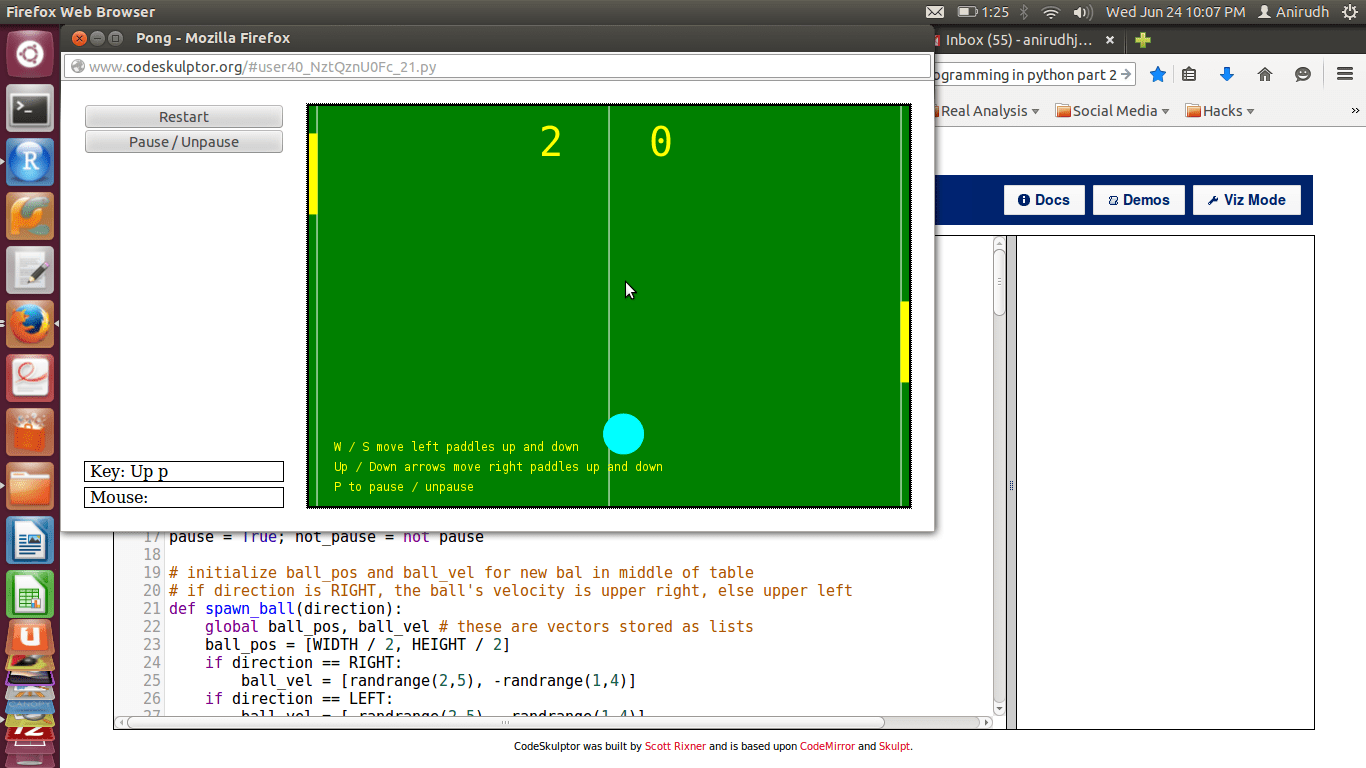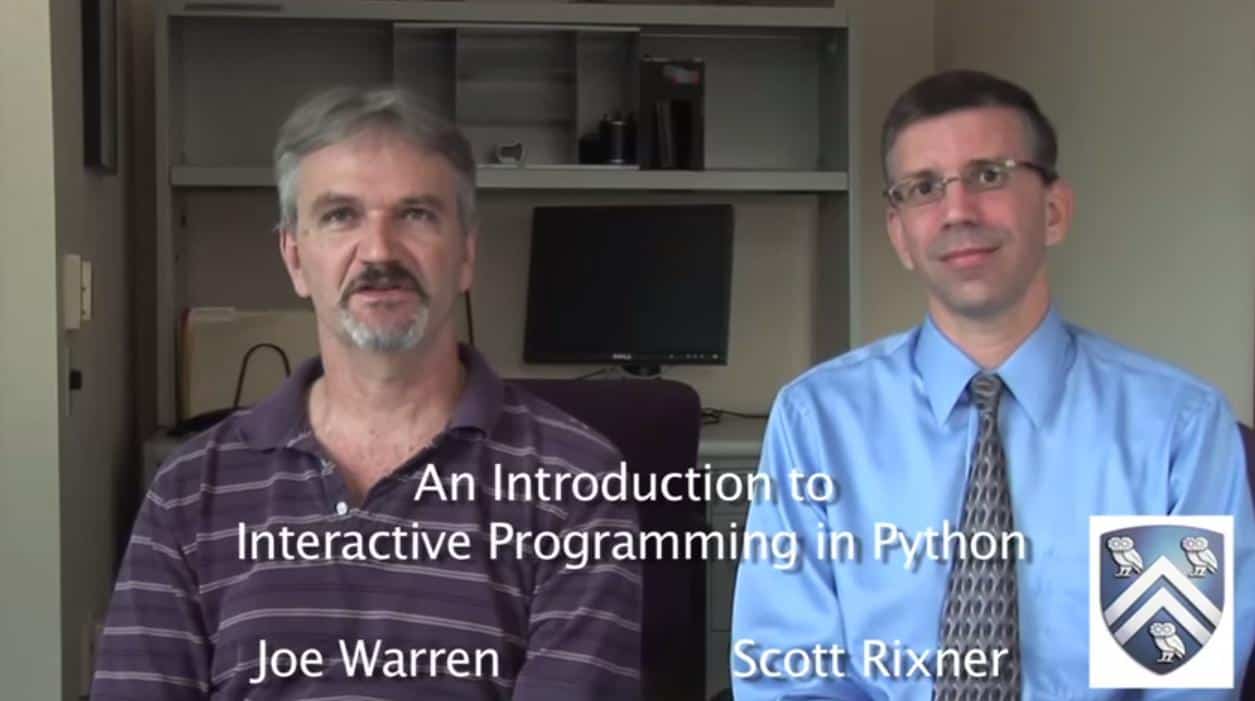In-Depth Review: An Introduction to Interactive Programming in Python (Part 1)
Detailed review by Class Central user Anirudh Jayaraman on this project based introduction to interactive Python.
Review by Anirudh Jayaraman. Originally published here. Took the course? Write your own review here. Read all reviews.
This class (Part 1 of a 2-part course on interactive programming using Python – and the first course of the Fundamentals of Computing Specialization offered by Rice University) was an excellent introduction to programming because of its focus on building interactive (and fun) applications with the lessons learned each week. Most introductory coding classes start with text based (boring?) programs, while all through this course you’re required to build a series of projects that get progressively complicated with every passing week. I’m not to be mistaken to be trashing conventional pedagogy, but then again, how many gifted coders do you know who learned to code after completing all the exercises, cover-to-cover of some programming textbook? The best way to learn to enjoy coding would be to build interactive stuff, and this course scores full points on that.
A short introduction to the class in a charmingly nerdy way
The mini-projects / assignments during the course are implemented on a cloud-based environment called CodeSkulptor (built by Scott Rixner, one of the instructors for this course). I found CodeSkulptor unique, in that it allows you to share your code (because it’s browser based) with just about anyone with an Internet connection and makes you work with a graphic user interface (GUI) module similar to Pygame, called Simplegui. It also had a debugging tool, called Viz Mode that helped visualize the process. It eases the task of debugging your code and you’ll realize how cool it is as you start using it more.
I especially enjoyed peer grading – for each mini project we completed, we had to evaluate and grade the work of 5 others.
Since the course mini-projects were peer-reviewed, evaluating other people’s code also became a more straight-jacket affair, as everyone has their code on the same version of Python. This ensures that the focus is on learning to code, without wasting time on the logistics of programming environment (tuning differences in versions or IDEs). I especially enjoyed peer grading – for each mini project we completed, we had to evaluate and grade the work of 5 others. This was very rewarding – because I got the opportunity to fix bugs in others’ code (which makes you a better coder, I guess) and also got to see better implementations than the ones I had coded, further enriching the learning experience. Indeed, the benefits of peer grading and assessment have been well studied and documented.
Of all the assignments, the one I loved the most was implementing the classic arcade game Pong. You could try playing a version of the game I implemented here. It is a 2-player implementation, but you can play it as a single-player game, only if you imagine yourself to be answering this somewhat cheeky question! Which Pong character are you? Left or Right?
The principal reason behind my joining this course was the way it is structured and taught. We had to watch two sets of videos (part a and part b) and then complete one quiz for each set. The main task for each week was to complete a mini-project that was due along with the quizzes early Sunday morning, followed by assessment of peers’ mini-projects on the following Sunday-Wednesday. The instructors clearly put in A LOT OF WORK to make the lecture videos interesting, laced with humor, with just enough to get you going on your own with the week’s mini-project. That way you’d spend less time viewing the lecture videos, spending more time on actually getting the code for your mini-project to work. So in a way, one might say this course doesn’t follow standard pedagogy for an introductory programming course, but then, as Scott Rixner assures, “You’d know enough to be dangerous!”
The instructors clearly put in A LOT OF WORK to make the lecture videos interesting, laced with humor, with just enough to get you going on your own with the week’s mini-project.
PROJECTS
The projects that were completed in Part 1 of this course were indeed exciting:
– Rock Paper Scissors Lizard Spock: A simple implementation played with the computer. This project covers basics on statements, expressions and variables, functions, logic and conditionals [I’m a huge fan of The Big Bang Theory, so I was obviously eager to complete this game. Instead of a series of if-elif-else clauses, this implementation used modular logic, all of which is taught in a really fun way. A great way to start off the course].
– Guess the Number: Computer chooses a random number between 1 and 100 and you guess that number. It covered event-driven programming, local and global variables, buttons and input fields [This game although fun, might have been more interesting to code if the computer had to guess the number that the player chose, using bisection search].
– Stopwatch: This was the first project that used a graphic user interface, using some modular arithmetic to get the digits of the ticking seconds in place. A game was also built on it where the player had to stop the watch right at the start of a second to score points. This game tested your reaction-time. It covered static drawing, timers and interactive drawing.
– Pong: The last project of Part 1 and the most fun. Creating the game required only a minor step-up from learnings from previous weeks. It covered knowledge of lists, keyboard input, motion, positional/velocity control. Coding the ball physics where you put to use high-school physics knowledge of elasticity and collisions was very enjoyable. In my game, I set elasticity = 1 (for perfectly elastic collisions)
INSTRUCTORS
You’ll always find help available within minutes of posting your doubts and queries on the forums.
In an interview with the founders of this MOOC, they say that they have spent over 1000 hours building it (Part 1 and Part 2 combined, I guess). That’s an awful lot of effort and it all shows in how brilliantly the class is executed. The support system in the class is excellent. You’ll always find help available within minutes of posting your doubts and queries on the forums. I’ve seen Joe Warren (one of the main instructors of the course) replying to forum posts quite regularly. In addition, there was enough supplementary material in the form of pages on concepts and examples, practice exercises, and video content created by students from previous iterations of the class to better explain concepts and aspects of game-building, improving upon the lecture material.
CONCLUSION
Overall, I had a great learning experience. I completed Part 1 with a 100 per cent score even though I had a minor hiccup while building the game Pong, which was the most satisfying of all the projects in Part 1. I would review Part 2 when I’m done with that in August this year. I’d easily recommend this course to anyone wishing to start off with Python. It is a great place to be introduced to Python, but it shouldn’t be your ONLY resource. I have been taking MIT’s 6.01x introductory Python course side-by-side. I shall review that course as soon as I’m through with it. That course is pedagogically more text-bookish, and indeed they do profess the use of their textbook to complement the course. I’m 3 weeks into that course and finding that enjoyable too – albeit in a different way. I still haven’t lost a point on any of the assignments or finger exercises there, and hope the trend continues.
Class Central is looking for reviewers and regular contributors. If you’ve ever finished a MOOC and want to write a critique to help future students considering taking that course, we want to hear from you. Drop us a mail.










